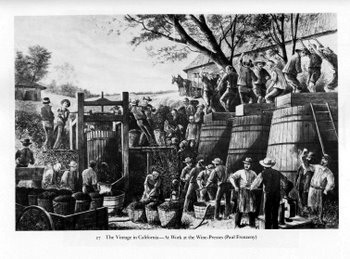Column: Arbor Vinous
Did you know that Monroe was once Michigan’s grape-growing capital – but nobody’s ever figured out if they made wine there?
Or that Chinese coolies who arrived to build the U.S. railroads ended up stomping huge vats of grapes for California wineries during the 1870s?
Neither did I.
I gleaned these tidbits from Dan Longone, curator of “500 Years of American Grapes and Wine,” on exhibit through May 29 at the University of Michigan’s Clements Library, on South University just east of UM president Mary Sue Coleman’s house.
If you visit, expect a cornucopia of grape and wine ephemera, from early British books instructing New World settlers on grape cultivation to a wine list from Detroit’s London Chop House, circa 1969.
A sign called my attention to the 1827 American origins of the word cocktail: “If Europe brought wine to the New World, we brought the cocktail to the Old.”
Bordeaux versus a Martini? Not much contest there.
Those Monroe grapes? The French originally settled the area and named the Riviere Raisin – which Anglicizes as Grape River.
Longone will give a public talk on the exhibit at 3 p.m., May 10, at the library. If our two-hour conversation offered any kind of preview, this born raconteur will offer tales aplenty about grapevines and their pleasure-giving progeny.
We sat down to talk. “Any human emotion has been expressed through or with wine,” Longone told me.
“I say to groups of students, ‘Let me tell you what you can learn about wine,’” he continued. “There’s religion. Power politics. Prohibitionists and anti-prohibitionists. Some of the arguments that went on then remind me of evolution versus creationism.”
Wow.
Chemistry Professor Emeritus Dan Longone and his wife, Jan, belong to a not-uncommon Ann Arbor genus: folks with outsize national or international reputations in their specialties but low profiles in their hometown.
In their case, that specialty would be culinary and wine history. They’ve spent 40-plus years on a first-name basis with generations of gastronomic gurus, the likes of James Beard and Craig Claiborne. They’ve bunked at the home of Julia Child.
Dan still chuckles when he recalls Zingerman’s Ari Weinzweig dashing over to their house to share some of the first bread samples to emerge from the Bakehouse.
While Dan focused on wines and grapes, Jan Longone turned her academic background and food interests into a business as a nationally known buyer, seller and collector of cookbooks, menus, advertisements and other artifacts of culinary history. Their 2005 donation created the Janice Bluestein Longone Culinary Archive at Clements, which instantly became one of the premier national resources in the field.
“In the past, that’s the kind of thing no library would consciously collect,” Longone said. “If you gave them a box of junk – to them it’s junk – they wouldn’t know what to do with it. How do you catalog 500 pieces of paper that have nothing to do with great men?”
The exhibition combines some items from the Archive with others from his personal collection. He doubts that it could be mounted anywhere else in the world.
“The University of California at Davis has a better technical collection – foreign journals and a whole host of things of interest to the practical winemakers of California,” Longone said.
“But because of our academic backgrounds, ours is a ‘reasoned collection’ – a deliberate attempt to capture, not simply to get prize books and never open them,” said Longone.
“Our interest is ‘What is wine? How did it start? What effect has it had?’ So one begins to collect these books, look at them, and say, ‘These are exactly the problems we have now. How did they solve them then?’”

Harvest time in California. Harpers Weekly, 1878. {Courtesy of Longone Culinary Archive/Clements Library)
Longone points to the 1878 Harpers Weekly illustration of Chinese workers stomping grapes in California, holding onto branches above the vats to keep their balance. He compares this to one of the oldest-known pieces of wine art – a tomb painting from 1400 B.C. Thebes in which grape-stompers are grabbing hoops for the identical purpose.
Jan Longone contemplates a “bittersweet” retirement later this year as the volunteer curator of the Clements archive. But she’s proud that her replacement will be the first paid professional curator of a culinary history archive anywhere in the world.
Dan and Jan Longone met as teenagers whose families spent summers on Revere Beach, near Boston. They married after college and both went on to grad school at Cornell, where they first developed an interest in wine as part of a meal. They landed in Ann Arbor 50 years ago, in 1959, for Dan’s job teaching chemistry at UM.
“When we came to Ann Arbor, this was pretty much a dry town,” Longone recalled. “You had to join a club – the Town Club – if you wanted to entertain with drinks, even wine.”
“Most people entertained at home, partly because of this problem with drinks. So Jan honed her instincts and became known for food and history of food.”
In 1975, Jan Longone began to host what she believes to be public radio’s first culinary show, Adventures in Gastronomy, which originated at the studios of WUOM.
They jointly taught UM extension courses on French food (Jan) and wine (Dan). Since alcohol wasn’t allowed on campus, they found an off-campus venue for their wine tastings: Pioneer High School. Dan also toured the country, visiting chapters of the American Chemical Society to deliver what he called his “one night stand” wine lectures.
In the early 1970s, they began the Ann Arbor Food and Wine Society. Through an arrangement with Village Corner, they tasted and selected wines to offer members at reduced prices. Members organized theme dinners at one another’s homes or Elizabeth’s Restaurant in Northville, which allowed customers to BYO.
Longone waxed eloquent over the dramatically improved food resources available today in Ann Arbor.
“How can you believe Zingerman’s? How can you believe the fish down at Monahan’s?” he enthused.
“Obviously, they’re not cheap. But Zingerman’s has shown us that special food is not cheap. Take it or leave it.”
But like many wine lovers, Longone does raise an eyebrow at the wine markups he sees in restaurants.
“You look at a wine and say, ‘My god, they’re charging $30 and it’s a $10 retail bottle that they paid $8 for. We generally won’t order it. We don’t have to have wine; we can do without it.”
I have to ask. Is it possible for them to simply enjoy going out to dinner at an ordinary restaurant?
“It doesn’t have to be haute cuisine,” Longone replied. “But two things: we like perfect produce, if available, done very simply. And since we’re from New England, we like fish.”
“In Ann Arbor, we do go out occasionally. Invariably, we will go to an ethnic restaurant. We like Indian food, we like Chinese food.”
“But we don’t go out very much,” he acknowledged. “We say, ‘Let’s wait until we get to France this fall, and that’s where we’ll spend the money.’”
About the author: Joel Goldberg, an Ann Arbor area resident, edits the MichWine website. His Arbor Vinous column for The Chronicle is published on the first Saturday of the month. If you’d like to keep up with local wine events, visit MichWine’s Ann Arbor wine calendar. To list your event on the calendar, submit it here.






Great article Joel! I will definately make it to the Clements this month!!
I hope the Chronicle continues to run these articles.
But of course!